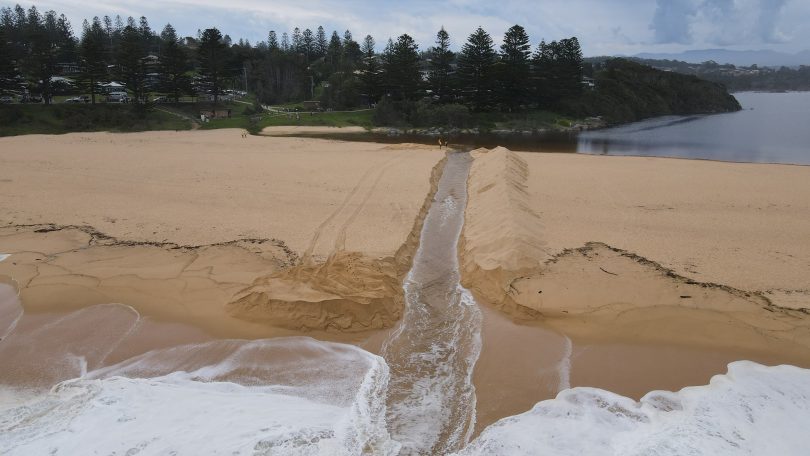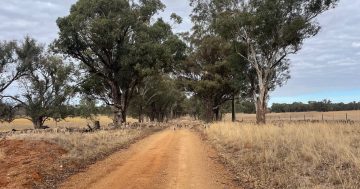
Coila Lake opens to the ocean via a new channel that was created this week to cater for overflow. Photo: Ocean View Photography Maree Jackson, Facebook.
Eurobodalla Shire Council has ploughed open a channel for Coila Lake after its waters surpassed the two-metre trigger level.
Photographs on social media before the channel was opened on 4 January show the lake brimming with water and close to the roadway and pedestrian footbridge at Tuross Head. When overly full, Coila Lake threatens tanks at Coila Service Centre and can damage the sub-base of the Princes Highway along the Coila straight.
Coastal lakes under council’s control are opened in accordance with water trigger levels that were formulated through consultation with NSW National Parks and Wildlife Service, NSW Department of Primary Industries (DPI) and NSW Crown Lands.
Coila Lake is classified as an intermittently closed and open lake and lagoon (ICOLL) which is largely governed by natural processes rather than being artificially managed. There are about 70 ICOLLs in NSW and there’s usually no interference unless assets are at risk of being flooded.
In natural cycles, ICOLLs open and close to the ocean constantly, but irregularly. Water levels can often rise rapidly in response to storms, and eventually the water will spill over the entrance sand berm and drain to the ocean. The force of the backed up water then quickly scours an entrance channel through the beach and reopens the lake to the ocean.
It’s common for many ICOLLs to remain closed for several years, and historical records show that about 70 per cent of the ICOLLs in NSW are closed the majority of the time. As well as rainfall, specific local conditions such as catchment size and headlands near the entrance determine if an ICOLL is mostly open or mostly closed.
“We open them only when the trigger levels are reached, or are likely to be exceeded with pending rainfall,” said a statement from Eurobodalla Shire Council.
A crowd gathered on Tuross Boulevarde and the Coila Lake foreshore to watch the channel being dug, a process that takes around two hours. The dig takes place ahead of high tide and the outgoing tide, enabling the water flow to substantially widen the channel. That, in turn, provides relief for farmers and infrastructure further up the lake catchment.
There’s local contention about how best to open the waterway and keep it open for a more prolonged period.
The current channel should remain open for several days at least, relieving pressure on the system before the lake returns to its normal level.
While council manages the Coila Lake process directly, the DPI says flooding and drying are natural components of the hydrological and ecological processes operating within ICOLLs.
“Coastal lakes and the life they support have evolved in response to these forces, and to maintain a ‘healthy’ lake ideally it should be left to operate as close to natural as possible,” said a DPI statement.
The DPI said that overly frequent artificial opening risks destroying an ICOLL’s naturally regulating system, describing them as “dynamic coastal environments – they are significantly different from bays, harbours or inlets which are permanently open to the sea”.










